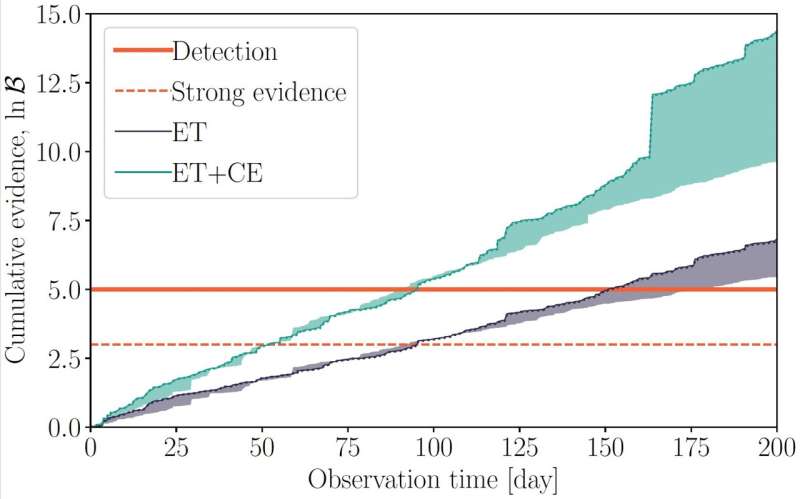
Model selection between original BMS symmetries (dashed lines) and extended BMS symmetries (solid lines) with the Einstein Telescope (ET) and Cosmic Explorer (CE). The evidence for the simulated symmetry group (log Bayes factor) is shown as a function of observation time. Credit: Physical Exam Letters (2024). DOI: 10.1103/PhysRevLett.132.241401
As predicted by the theory of general relativity, the passage of gravitational waves can cause a measurable change in the relative position of objects. This physical phenomenon, known as gravitational wave memory, could potentially be exploited to study both gravitational waves and spacetime.
Researchers from the Gran Sasso Science Institute (GSSI) and the International School for Advanced Studies (SISSA) recently conducted a study exploring the possibility of using gravitational wave memory to measure spacetime symmetries, fundamental properties of spacetime that remain the same after specific transformations. Their paper, published in Physical Exam Letterssuggests that these symmetries could be probed through the observation of spin displacement and memory.
“I have long been curious about the phenomenon of gravitational wave memory and the connection between associated low-energy physics and quantum mechanics,” Boris Goncharov, co-author of the paper, told Phys.org. “I first heard about Weinberg’s soft graviton theorem from Professor Paul Lasky of Monash University in Australia, during my PhD, when I was discussing gravitational wave memory. Then I discovered the so-called ‘infrared triangle’ that connects the soft theorem to gravitational wave memory and spacetime symmetries at infinity from gravitational wave sources.”
Weinberg’s soft graviton theorem and the “infrared triangle” are mathematical formulations describing the same physical phenomenon: gravitational wave memory. In their recent study, Goncharov and his colleagues set out to explore the possibility of exploiting gravitational wave memory to probe spacetime symmetries.
“This phenomenon plays a role in an ongoing attempt to describe Einstein’s century-old, unsinkable and yet microscopically incompatible theory of gravity – general relativity – as a quantum field theory at the asymptotic limit of spacetime,” Goncharov said.
“This approach to unifying physics seems substantial and promising to me; I find it very exciting. Our specific project was born while discussing new advances in this field with Professor Laura Donnay, co-author of the publication.”
In reviewing the existing literature in this area, the researchers found that a growing number of deep spacetime symmetries were being discussed, but it was unclear which of these symmetries and the corresponding memory terms existed in nature. While several physicists had explored the possibility of detecting gravitational wave memory, Goncharov and his colleagues were unsure of the physics that could be constrained using their measurements.
“The idea of being able to test these spacetime symmetries was at the heart of our study,” Goncharov explains. “Another aspect is that Professor Jan Harms and I are members of the Einstein Telescope Collaboration, for which it was important to study the prospects for observing gravitational wave memory. The Einstein Telescope is the next-generation European terrestrial gravitational wave detector planned for the 2030s.”
Until now, researchers had not yet implemented a conventional approach to measuring spacetime symmetries through the observation of gravitational wave memory effects. The recent paper by Goncharov and colleagues aimed to fill this apparent gap in the literature.
“A lot of important work has been done before, including (a) predicting the timing and instruments to detect different gravitational-wave memory terms, (b) how to calculate gravitational-wave memory effects analytically or using numerical relativity, and (c) how different models of spacetime symmetries produce gravitational-wave memory terms,” Goncharov said. “However, a discussion of spacetime symmetries based on observed memory effects seemed to be a gap in the literature.”
The recent work of these researchers can be considered a proof of principle. In their paper, they present new observational tests that could be used to probe spacetime symmetries, while highlighting potential limitations of their suggested approach, which could be addressed in the future.
Overall, their study suggests that the range of tests for the general theory of relativity could be expanded. In addition, it provides useful calculations that could be performed using data collected by various gravitational wave detectors.
Goncharov and his colleagues hope their paper will open new discussions about spacetime symmetries and gravitational wave memory within their research community. These discussions could potentially pave the way for unifying various theories of physics.
“Currently, together with Sharon Tomson (a new PhD student at my current institute, AEI in Hannover, Germany), and Dr. Rutger van Haasteren, I am starting research on gravitational wave memory with Pulsar Timing Arrays (PTAs).”
PTAs are astronomical observation tools that collect very stable and regular signals from pulsars (i.e., rapidly rotating neutron stars), using radio telescopes on Earth. These neutron stars behave like high-precision clocks, because they are sensitive enough to detect delays and advances in radio pulses resulting from the propagation of gravitational waves through the Milky Way.
“PTAs are galactic-scale detectors, which currently appear to be gradually picking up a co-hum of slowly spiraling supermassive binary black holes in the nearby Universe. The signal produces slow variations in the arrival times of the pulses that are most pronounced on time scales of years to decades,” Goncharov added.
“A remarkable merger of supermassive binary black holes in a nearby galaxy could cause a burst of gravitational waves with memory, detectable by PTAs. Although such bursts are very rare, we hope to extract useful information from the data by limiting their existence.”
More information:
Boris Goncharov et al., Deduction of fundamental symmetries of spacetime with gravitational wave memory: from LISA to the Einstein telescope, Physical Exam Letters (2024). DOI: 10.1103/PhysRevLett.132.241401. On arXiv: DOI: 10.48550/arxiv.2310.10718
© 2024 Science X Network
Quote:Exploring the Possibility of Probing Fundamental Symmetries of Spacetime via Gravitational Wave Memory (2024, July 6) retrieved July 6, 2024 from https://phys.org/news/2024-07-exploring-possibility-probing-fundamental-spacetime.html
This document is subject to copyright. Apart from any fair dealing for the purpose of private study or research, no part may be reproduced without written permission. The content is provided for informational purposes only.